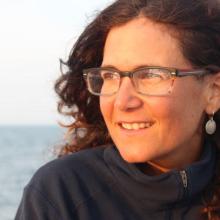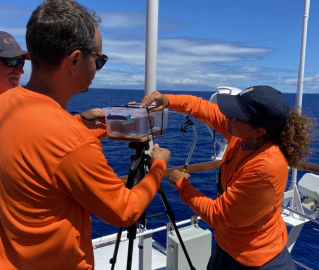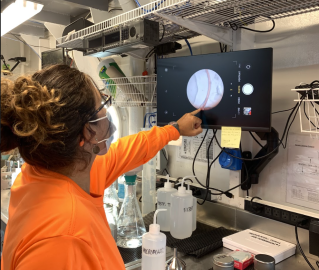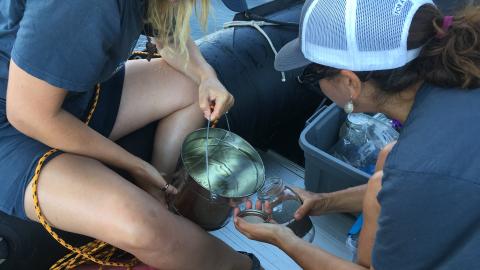
Rachael Miller
What is your history of engagement with the National Geographic Society?
I became a National Geographic Explorer in 2019 for our expedition on the Hudson River investigating microplastics in the air, soil and water and have presented as part of NatGeo Classroom!
Tell us about your work/research. What kinds of things do you do?
My job is to protect the ocean - and the lakes and rivers that feed her. I do that in multiple ways but mostly with a focus on the global problem of marine debris. While my team and I work on derelict fishing gear, consumer debris, and microplastics, my own focus lately has been on microplastic and microfiber pollution. My goals are to create ways to prevent these problems, contribute scientific knowledge about them (in order to prevent and fix them) and spread the word to raise awareness so people in heaps of different industries can learn about these problems and apply their particular skills to finding solutions. I work to achieve those goals in different ways. For prevention, I am a co-inventor of the Cora Ball which is a laundry ball that goes in your washing machine and both reduces the amount of microfiber your clothes shed and helps collect what does shed before it can flow out of your drain and into the environment. This requires spending time with my team brainstorming ideas, building prototypes, testing them, and then launching those that work! My team and I contribute scientific knowledge by going on expeditions to understand the problem better. A recent expedition, from onboard our organization’s 60’ sailing research vessel, was to investigate how much and what kind of microplastic and microfiber exist in the air, water, and soil of an entire river from the mountains to the sea (we studied the Hudson River). Another recent study was one that showed that electric clothes dryers, like so many of us use, emit microfibers directly into the environment through their vents. We take our results from these expeditions and studies and publish our findings in peer-reviewed journals. Finally, I work to spread the word by giving presentations, sitting on panels, speaking at events, and chatting with people on podcasts. In those presentations, I tell the story of our expeditions, share our results and what they mean and discuss ways everyone can be part of the solutions to protect our one, big ocean.
What sparked your initial interest in your career?
I am not very graceful on land. But in the water, I feel at home - whether I am on or in the water (including snow), I am at my happiest. I am sure you've heard the phrase, "You protect what you love." My career is an example of that phrase coming to life. I will say that I did not know that I was born to protect the ocean as a career until around 10 years ago, but I did know I was connected to the water - both salt and fresh, liquid and frozen. Looking back, there were moments that planted the seed for what I am doing today...watching the crew throw hundreds of garbage bags off the back of a cruise ship while on a cruise with my grandparents when I was 16 and demanding to talk to the captain (I never got the chance), nearly stepping on a needle while playing frisbee on a beach in Miami and seeing trash in marinas and on beaches all over as I traveled as part of my university sailing team. Those experiences coupled with my enthusiasm to travel, explore and learn about the ocean, and its challenges, as well as spend as much time near, on and in the water, all set me in this direction.
What element of your work/study is the most fascinating?
Luckily, I find all of the fieldwork we do fascinating. Every bit of it. I find the people with whom I work fascinating. And I love creating programs, coming up with expeditions, developing activities based on our work, and sharing those experiences. To call out something specific, I would say that traveling the entire Hudson River from where it starts in the mountains to where it meets the Atlantic Ocean, twice, was spectacular. A whole river is a home to so many different ecosystems, so many types of human uses, population densities and features along its banks. The Hudson River is only really known for its neighboring New York City, but it is so beautiful. There are narrow sections that are like fjords with tall, tall cliffs, sections that you can whitewater raft, sections that flow with a lazy motion, overhanging trees and warm water, there are these beautiful little lighthouses that look like mini-mansions and if you look carefully and move up or down the river early in the morning, you can see bald eagles flying between the tree tops. In addition to the expedition aspect of what I do, I also love weaving new technology into the expeditions. Being at the front edge of anything is extra exciting because you can’t always predict the outcome. We were one of the first to use ROVs (remotely operated vehicles) to both connect people to the underwater world right at their feet in urban harbors and search for (and remove) marine debris from the sea floor. We were some of the first to use drones to do recon missions on remote beaches to understand which beaches needed cleaning up. Currently, with our partner Dr. Claire Gwinnett from Staffordshire University, we are weaving forensic science into marine science and bringing polarizing light microscopes into citizen science!
What other jobs or skills led you to your current position?
Though sometimes what I was doing didn’t seem to make sense, when I look back, I realize that all of my paths lead me to where I am today, protecting the ocean. The breadth of what I studied in college from sciences to art to underwater archaeology helped me appreciate how important and useful it is to think in an interdisciplinary way. After college, I embarked on an Olympic campaign in sailing (a single-handed boat, so just me in a small sailboat). I did all of my own logistics and fundraising. While I did not make the Olympic team, I learned an incredible amount about moving equipment (and myself) around the world, how to interact with coaches and specialists, and thanks to giving slide shows of my experiences, how to take photos that help tell about those experiences. In terms of jobs, I was the director of a nonprofit community sailing center where I learned about nonprofit management, leading a team and creating programs. After that, I had my own business teaching kitesurfing, windsurfing and snowkiting as well as using ROVs to take people on shipwreck exploration cruises on Lake Champlain. That taught me what it takes to be in charge of everything from admin to the execution of the programs. I also gained experience flying and fixing ROVs and experiencing the wonder of exploring underwater without throwing anyone overboard! I use all of those skills as part of what I am doing with Rozalia Project and Cora Ball. From a skills perspective, I think my energy (I have a lot), willingness to try new things not just new to me, but things that other people haven’t done before, interest in making an impact, seeking out people who compliment rather than replicate my skill set and an eagerness to receive constructive feedback, all have been a big help getting me to where I am today.
What are your degrees and certifications?
Bachelor of Arts in Anthropology (underwater archaeology) -- Brown University 1993; USCG Captain with an endorsement for auxiliary sail
What are your hobbies?
I am happiest and do my best thinking in motion, especially when doing human and wind-powered water sports. My favorites are a newish sport called wing foiling along with riding waves on a surfski, though I also love sailing, swimming, freediving, snowkiting and standup paddleboarding. I also love sports that use gravity for extra fun, specifically mountain biking and skiing - alpine (moguls!!) and nordic (especially skate skiing). When I need a rest or the weather is really terrible, I enjoy sketching and dreaming up new expeditions!
What advice would you give someone who wants to have a career like yours?
If you are someone who likes every day to be different, enjoys learning a wide variety of skills and has a lot of internal motivation, then a path like mine might be as fulfilling and energizing for you as it has been for me. In that case, first know that you can achieve your goals. Going in with confidence and the willingness to walk through open doors is incredibly important. And then, I recommend finding opportunities to live and learn about the experiences you envision - that might mean as a volunteer, as an intern, or as part of a program or a class. Getting your hands muddy, salty and sandy is the only way to really learn and know if what you think will inspire you, really does. Realize that you will need amazing people with whom to share the work, the joy and the problem-solving. When you find awesome people, keep them. Collect them and create a team - even if they are geographically apart and come from different academic or professional disciplines. In fact, that diversity will make your team stronger! Lastly, remember that, especially if you are doing something new, it is a process of trying, learning, making adjustments and trying again. Control the controllables, enjoy the process, enjoy the people, enjoy the places and stick to what you believe will make an impact!
Expeditions
Rachael participated in the following Ocean Exploration Trust expeditions:




